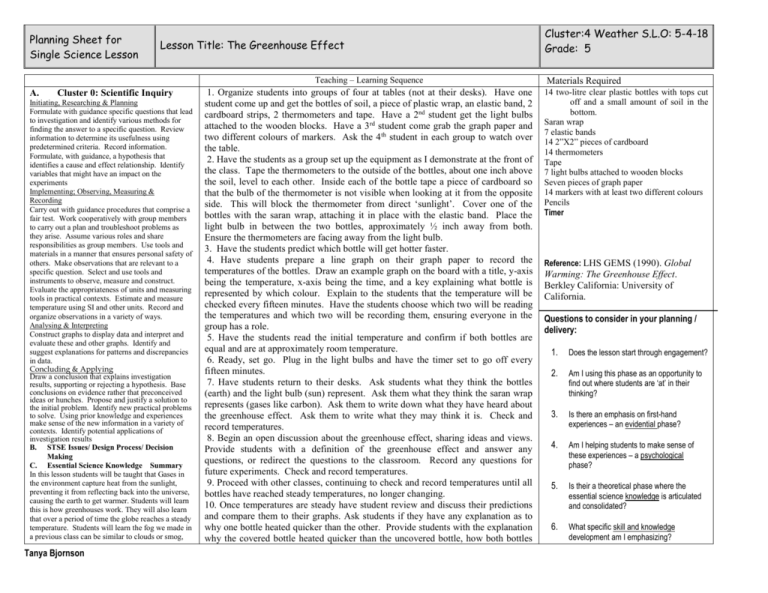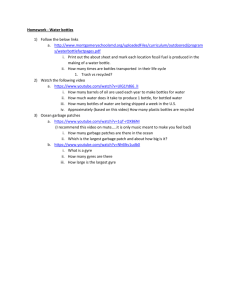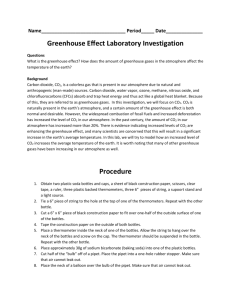Greenhouse Effect - Lesson
advertisement

Planning Sheet for Single Science Lesson Lesson Title: The Greenhouse Effect Teaching – Learning Sequence A. Cluster 0: Scientific Inquiry Initiating, Researching & Planning Formulate with guidance specific questions that lead to investigation and identify various methods for finding the answer to a specific question. Review information to determine its usefulness using predetermined criteria. Record information. Formulate, with guidance, a hypothesis that identifies a cause and effect relationship. Identify variables that might have an impact on the experiments Implementing; Observing, Measuring & Recording Carry out with guidance procedures that comprise a fair test. Work cooperatively with group members to carry out a plan and troubleshoot problems as they arise. Assume various roles and share responsibilities as group members. Use tools and materials in a manner that ensures personal safety of others. Make observations that are relevant to a specific question. Select and use tools and instruments to observe, measure and construct. Evaluate the appropriateness of units and measuring tools in practical contexts. Estimate and measure temperature using SI and other units. Record and organize observations in a variety of ways. Analysing & Interpreting Construct graphs to display data and interpret and evaluate these and other graphs. Identify and suggest explanations for patterns and discrepancies in data. Concluding & Applying Draw a conclusion that explains investigation results, supporting or rejecting a hypothesis. Base conclusions on evidence rather that preconceived ideas or hunches. Propose and justify a solution to the initial problem. Identify new practical problems to solve. Using prior knowledge and experiences make sense of the new information in a variety of contexts. Identify potential applications of investigation results B. STSE Issues/ Design Process/ Decision Making C. Essential Science Knowledge Summary In this lesson students will be taught that Gases in the environment capture heat from the sunlight, preventing it from reflecting back into the universe, causing the earth to get warmer. Students will learn this is how greenhouses work. They will also learn that over a period of time the globe reaches a steady temperature. Students will learn the fog we made in a previous class can be similar to clouds or smog, Tanya Bjornson 1. Organize students into groups of four at tables (not at their desks). Have one student come up and get the bottles of soil, a piece of plastic wrap, an elastic band, 2 cardboard strips, 2 thermometers and tape. Have a 2nd student get the light bulbs attached to the wooden blocks. Have a 3 rd student come grab the graph paper and two different colours of markers. Ask the 4 th student in each group to watch over the table. 2. Have the students as a group set up the equipment as I demonstrate at the front of the class. Tape the thermometers to the outside of the bottles, about one inch above the soil, level to each other. Inside each of the bottle tape a piece of cardboard so that the bulb of the thermometer is not visible when looking at it from the opposite side. This will block the thermometer from direct ‘sunlight’. Cover one of the bottles with the saran wrap, attaching it in place with the elastic band. Place the light bulb in between the two bottles, approximately ½ inch away from both. Ensure the thermometers are facing away from the light bulb. 3. Have the students predict which bottle will get hotter faster. 4. Have students prepare a line graph on their graph paper to record the temperatures of the bottles. Draw an example graph on the board with a title, y-axis being the temperature, x-axis being the time, and a key explaining what bottle is represented by which colour. Explain to the students that the temperature will be checked every fifteen minutes. Have the students choose which two will be reading the temperatures and which two will be recording them, ensuring everyone in the group has a role. 5. Have the students read the initial temperature and confirm if both bottles are equal and are at approximately room temperature. 6. Ready, set go. Plug in the light bulbs and have the timer set to go off every fifteen minutes. 7. Have students return to their desks. Ask students what they think the bottles (earth) and the light bulb (sun) represent. Ask them what they think the saran wrap represents (gases like carbon). Ask them to write down what they have heard about the greenhouse effect. Ask them to write what they may think it is. Check and record temperatures. 8. Begin an open discussion about the greenhouse effect, sharing ideas and views. Provide students with a definition of the greenhouse effect and answer any questions, or redirect the questions to the classroom. Record any questions for future experiments. Check and record temperatures. 9. Proceed with other classes, continuing to check and record temperatures until all bottles have reached steady temperatures, no longer changing. 10. Once temperatures are steady have student review and discuss their predictions and compare them to their graphs. Ask students if they have any explanation as to why one bottle heated quicker than the other. Provide students with the explanation why the covered bottle heated quicker than the uncovered bottle, how both bottles Cluster:4 Weather S.L.O: 5-4-18 Grade: 5 Materials Required 14 two-litre clear plastic bottles with tops cut off and a small amount of soil in the bottom. Saran wrap 7 elastic bands 14 2”X2” pieces of cardboard 14 thermometers Tape 7 light bulbs attached to wooden blocks Seven pieces of graph paper 14 markers with at least two different colours Pencils Timer Reference: LHS GEMS (1990). Global Warming: The Greenhouse Effect. Berkley California: University of California. Questions to consider in your planning / delivery: 1. Does the lesson start through engagement? 2. Am I using this phase as an opportunity to find out where students are ‘at’ in their thinking? 3. Is there an emphasis on first-hand experiences – an evidential phase? 4. Am I helping students to make sense of these experiences – a psychological phase? 5. Is their a theoretical phase where the essential science knowledge is articulated and consolidated? 6. What specific skill and knowledge development am I emphasizing? which also will trap heat from the. Will you assess? If so, what? Students will be assessed on their participation and involvement and their graphs How will you assess it? Students will be assessed in their involvement in class discussions, in their small group discussions, their participation and use of the roles during the experiment and their neatness and clarity of their graph. Tanya Bjornson allowed sun or heat in, but the covered one did not let it escape as quickly as the uncovered one. Compare the experiment to both a greenhouse and to the earth and global warming. Have students relate this experiment to the forming of fog and smog. Have a discussion with the class about what can be done to reduce global warming. 7. Is there evidence of clear instructions and purposeful questions in my teaching sequence?








